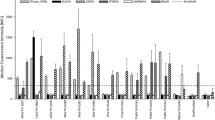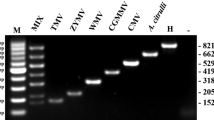Abstract
The partial nucleotide sequence of the RNA polymerase gene from one isolate of Pepino mosaic virus (PepMV) was determined. Phylogenetic and distance analysis indicated that this isolate was related to other isolates of PepMV previously reported. To develop a method for detecting PepMV by reverse transcriptase–polymerase chain reaction (RT–PCR), a pair of primers was designated from RNA polymerase sequences. RT–PCR with RNA from a large number of tomato samples with PepMV symptoms, positive controls of PepMV, weed samples containing PepMV, and other potexviruses as negative controls confirmed the specificity of the primers. Restriction endonuclease digestion of the RT–PCR products distinguished three restriction fragment length polymorphism (RFLP) types. The majority of isolates were included within type P1, which correspond with the PepMV isolates found in Europe. This type and type P2, which corresponded with the original PepMV isolated from Solanum muricatum, appear more closely related to each other than to type P3. Type P3 had completely different RFLPs from the other two types studied. It may represent a further line within the PepMV virus. The RT–PCR–RFLP assay is proposed as a rapid and easy method to detect and identify new isolates of the PepMV virus.
Similar content being viewed by others
References
French CJ, Bouthillier M, Bernardy M, Ferguson G, Sabourin M, Johnson RC, Masters C, Godkin S and Mumford R (2001) First report of Pepino mosaic virus in Canada and United States. Plant Disease 85: 1121
Gibbs A, Armstrong J, MacKenzie AM and Weiller GF (1998) The GPRIME package: Computer programs for identifying the best regions of aligned genes to target in nucleic acid hybridisation-based diagnostic tests, and their use with plant viruses. Journal of Virological Methods 74: 67–76
Jones RAC, Koenig R and Lesemann DE (1980) Pepino mosaic virus, a new potexvirus from pepino (Solanum muricatum). Annals of Applied Biology 94: 61–68
Jordá C, Lázaro-Pérez A, Font I, Lacasa A, Guerrero MM and Cano A (2000a) Nueva enfermedad en el tomate. Phytoma - España 119: 23–28
Jordá C, Lázaro-Pérez A, Martínez-Culebras PV, Medina V, Lacasa A, Guerrero MM, Cano A and Hita I (2000b) Avances en el conocimiento de un nuevo virus: el PepMV. Phytoma - España 121: 36–41
Jordá C, Lázaro-Pérez A, Martínez-Culebras PV and Abad-Campos P (2001a) First report of Pepino mosaic virus on tomato in Spain. Plant Disease 85: 1292
Jordá C, Lázaro-Pérez A, Martínez-Culebras PV and Lacasa A (2001b) First report of Pepino mosaic virus on natural hosts. Plant Disease 85: 1292
Kumar S, Tamura K, and Nei M (eds) (1993) MEGA: Molecular Evolutionary Genetics Analysis, v. 1.0. The Pennsylvania State University, University Park, Pennsylvania
Lázaro-Pérez A, Martínez-Culebras PV, Abad-Campos P and Jordá C (2002) A new disease in tomato crops caused by Pepino mosaic virus (PepMV). Diagnosis by different techniques. Proceedings of the 5th Congress of the European Foundation for Plant Pathology, pp 239–241
Lesemann DE, Dalchow J, Winter S and Pfeilstetter E (2000) Occurrence of Pepino mosaic virus in European tomato crops: Identification, etiology and epidemiology. Mitteilungen aus der Biologischen Bundesanstalt für Land-und Forstwirschaft, Berlin-Dahlem 376: 323
Mumford RA and Metcalfe EJ (2001) The partial sequencing of the genomic RNA of a UK isolate of Pepino mosaic virus and the comparison of the coat protein sequence with other isolates from Europe and Peru. Archives of Virology 146: 2455–2460
Saitou N and Nei M (1987) The neighbour-joining method: Anewmethod for reconstruction phylogenetic trees. Molecular Biology and Evolution 4: 406–425
Thompson JD, Higgins DG, Gibson TJ and Clustal W (1994): Improving the sensitivity of progressive multiple sequence alignment through sequence weighting, position-specific gap penalties and weight matrix choice. Nucleic Acids Research 22: 4673–4680
van der Vlugt RAA, Stijger CCMM, Verhoeven J and Lesemann DE (2000) First report of Pepino mosaic virus on tomato. Plant Disease 84: 103
Wright D and Mumford R (1999) Pepino mosaic virus (PepMV). First records in tomato in the United Kingdom. Plant Disease Notice, 89, CSL York
Author information
Authors and Affiliations
Corresponding author
Rights and permissions
About this article
Cite this article
Martínez-Culebras, P., Lázaro, A., Abad Campos, P. et al. A RT–PCR Assay Combined with RFLP Analysis for Detection and Differentiation of Isolates of Pepino Mosaic Virus (PepMV) from Tomato. European Journal of Plant Pathology 108, 887–892 (2002). https://doi.org/10.1023/A:1021247220932
Issue Date:
DOI: https://doi.org/10.1023/A:1021247220932




